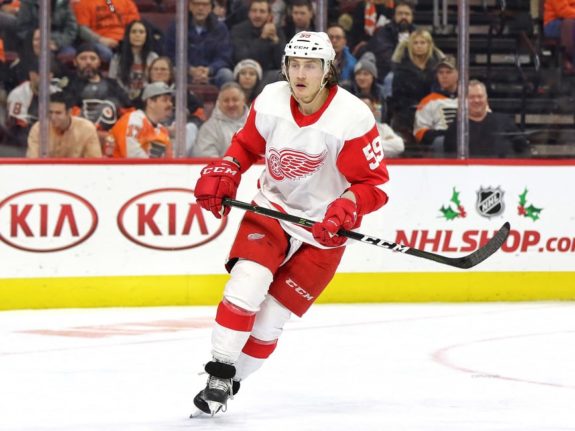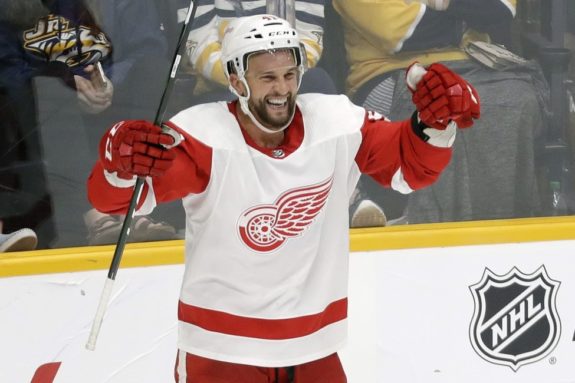What’s The Grind Line? Apart from the once-famous line of Kris Draper, Kirk Maltby, and either Joe Kocur or Darren McCarty, The Grind Line is also The Hockey Writers’ weekly column about the Detroit Red Wings. Rachel Anderson, Raymond Harrison, Jake Rivard, and Tony Wolak are the muckers who makeup THW’s forechecking unit and sound off on Red Wings topics.
—
The Detroit Red Wings started the season strong on Oct. 6, facing off at Bridgestone Arena against the mighty Nashville Predators. On paper, the Red Wings seemed likely to struggle against this contending roster, but the top line of Dylan Larkin, Anthony Mantha, and Tyler Bertuzzi flexed their creativity in a rousing 5-3 win. They quickly followed this up with another shocking 4-3 win against the Dallas Stars. Mantha potted four goals, becoming the first player to score four in a home opener since John Sorrell did it in 1933.
While the Red Wings are facing another tough rebuilding season, there’s plenty to be optimistic (and realistic) about. In this week’s edition of The Grind Line, The Hockey Writers’ Red Wings team will discuss the positives and negatives of the first game of the season.
Jake Rivard: Top Line Potential and Lack of Depth
The Red Wings’ top line has to be one of the deadliest the team has had in years. Larkin’s playmaking ability, Mantha’s deadly shot, and Bertuzzi’s relentlessness will give them plenty of opportunities to capitalize on throughout the season. During the season opener, that line generated the majority of the offense, with Mantha and Bertuzzi each scoring two goals. Mantha scored four in the home opener, and leads the team with six goals and eight points in two games. Seeing their energetic line spark the rest of the roster to a win is incredibly exciting.

There are pros and cons to having a top-heavy offense. Sure, the majority of your points will come from highly talented players, but what happens when their opponent has a shut-down defense against them?
The season opener made it apparent that the Red Wings are struggling with their depth. Andreas Athanasiou’s injury didn’t help, but the team’s lack of a supporting cast for the first line led to missed scoring opportunities and poor offense from the lower lines. Injuries forced Luke Glendening into a second-line role. He’s a perfectly competent player on his own, but he doesn’t have the offensive acumen needed for an NHL team’s second line.

A player on the Grand Rapids Griffins roster will inevitably shine above the rest and earn a call-up to the Red Wings. Until then, depth will be the Red Wings’ downfall.
Rachel Anderson: Energy & Uneven Production
The Red Wings were being molded into a more competitive team over the summer. Steve Yzerman’s goal was to create an atmosphere of encouraging competition, and it appears that he’s been successful thus far. The team’s energy is evident and, if consistent, could offer a glimpse into the level of play they will be striving for throughout the season.
The season opener against the Presdators was a success – primarily due to the top line of Larkin, Bertuzzi and Mantha. Luke Glendening also deserves a tip of the hat for his game-winning snipe. He was moved up to the second line after spending much of his career with the Red Wings playing on the third or fourth line.
The top line cannot be the only line producing. Stanley Cup teams do not rely on the talent of one man or one line, they are cohesive and balanced. Detroit needs to be careful not to rely too much on Bertuzzi – Larkin – Mantha. They set the standard and should encourage other lines to match their production. To be as competitive as Yzerman desires the team to be, the fourth line must create as much offensive pressure as the first.
Overall, the team is in pretty good shape. There is a good balance of youth and veteran leadership along with some promising prospects getting ready in the AHL. Can the team maintain its early energy? The Red Wings are hungry for success after so many seasons of coming up short, so that should be the motivator.